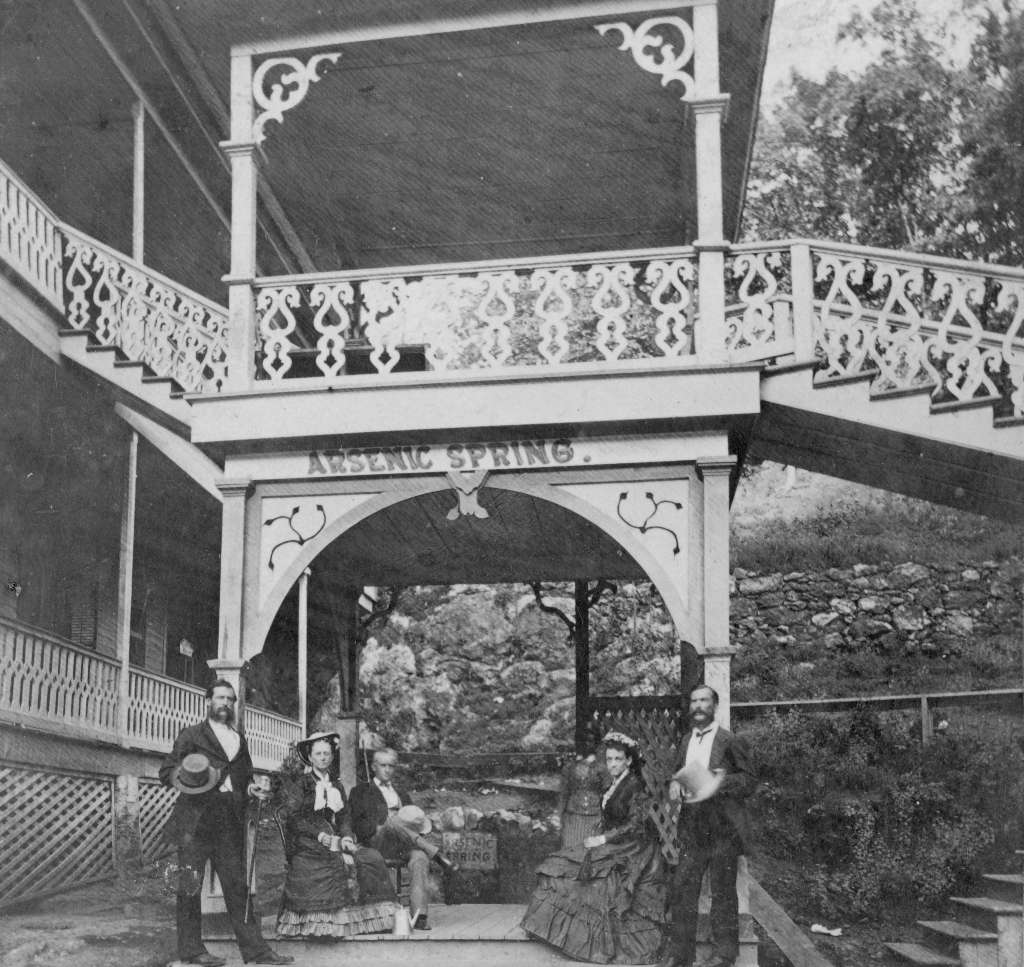
Arsenic Spring is the northernmost of the springs located along Hot Springs Creek. Historical photos show that the spring emerged at the base of a cliff of tufa. By the late 1800s, a Victorian-era wooden structure was built over the spring.
Despite its name, Arsenic Spring became a favorite drinking spring for nineteenth century visitors, particularly for women. A national publication in the 1870s wrote that Arsenic Spring was “in great repute among the fair sex, who fancy that it improves their complexion.”
Drinking the hot water from springs like Arsenic Spring was an important step in the hot springs treatment for health seekers. Physicians believed the hydrating waters helped flush out toxins. Though temperature and waterflow has changed over the years, in 1901, the water emerged at 134 degrees and 7.5 gal/minute.
Testing showed that it had a similar chemical profile to the other springs. Fortunately, there was no arsenic to be found in the waters.
The water of Arsenic Spring temporarily dried up in the 1880s, when blasting along the base of Hot Springs Mountain interrupted the flow of thermal water.
By 1901, Arsenic Spring was inaccessible underneath the Arlington Hotel. Following the destruction of Arlington Hotel due to fire in the 1920s, the Arsenic Spring was covered by tufa and dirt.
Eventually the spring water was combined into the park’s common collection system. Today’s hot water fountains in the park include the water of Arsenic Spring.
Despite its name, Arsenic Spring became a favorite drinking spring for nineteenth century visitors, particularly for women. A national publication in the 1870s wrote that Arsenic Spring was “in great repute among the fair sex, who fancy that it improves their complexion.”
Drinking the hot water from springs like Arsenic Spring was an important step in the hot springs treatment for health seekers. Physicians believed the hydrating waters helped flush out toxins. Though temperature and waterflow has changed over the years, in 1901, the water emerged at 134 degrees and 7.5 gal/minute.
Testing showed that it had a similar chemical profile to the other springs. Fortunately, there was no arsenic to be found in the waters.
The water of Arsenic Spring temporarily dried up in the 1880s, when blasting along the base of Hot Springs Mountain interrupted the flow of thermal water.
By 1901, Arsenic Spring was inaccessible underneath the Arlington Hotel. Following the destruction of Arlington Hotel due to fire in the 1920s, the Arsenic Spring was covered by tufa and dirt.
Eventually the spring water was combined into the park’s common collection system. Today’s hot water fountains in the park include the water of Arsenic Spring.
Is there something we missed for this itinerary?
Itineraries across USA

Acadia

Arches National Park

Badlands

Big Bend

Biscayne

Black Canyon Of The Gunnison

Bryce Canyon

Canyonlands

Capitol Reef

Carlsbad Caverns

Channel Islands

Congaree

Crater Lake

Cuyahoga Valley

Death Valley

Dry Tortugas

Everglades

Gateway Arch

Glacier

Grand Canyon

Grand Teton

Great Basin

Great Smoky Mountains

Guadalupe Mountains

Haleakalā

Hawaiʻi Volcanoes

Hot Springs

Indiana Dunes

Isle Royale

Joshua Tree

Kenai Fjords

Kobuk Valley

Lassen Volcanic

Mammoth Cave

Mesa Verde

Mount Rainier

North Cascades

Olympic

Petrified Forest

Pinnacles

Rocky Mountain

Saguaro

Shenandoah

Theodore Roosevelt

Virgin Islands

Voyageurs

White Sands

Wind Cave

Yellowstone

Yosemite

Zion